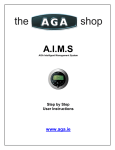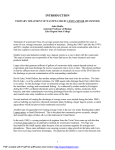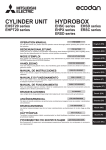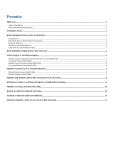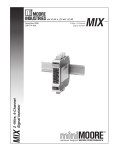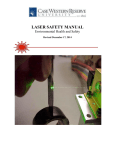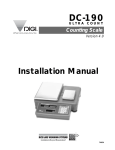Download TAMU regulations and guidelines for laser use.
Transcript
Texas A&M University Office of Radiological Safety Laser Safety Program Manual Radiological Safety Program Manual (Part Three) Radiological Safety Environmental Health and Safety Texas A&M University 4472 TAMU College Station, TX 77843-4472 Telephone: (979) 845-1361 Fax: (979) 862-7804 Website: http://ehsd.tamu.edu Email: [email protected] Revised 4/5/2013 Rev. 1 Introduction The Texas A&M University Laser Safety Program Manual sets forth controls and safety guidance for research and educational activities involving lasers. This program is established to protect personnel from effects such as skin burns or eye injuries and to meet the requirements of 25 Texas Administrative Code §289.301. If any conflict occurs between this Program Manual and the Code, the latter shall prevail unless the manual is more restrictive. This manual is not intended to be an exhaustive or fully comprehensive reference, rather a guide for registered users. Further advice concerning hazards associated with specific substances, devices, and the development of new or unfamiliar activities should be obtained through consultation with the Laser Safety Officer (LSO). All users of lasers and laser-producing devices must be familiar with the requirements set forth in this manual and all applicable regulations of the Texas Department of State Health Services (DSHS), and must conduct their operations in accordance with them. Title 25 of the Texas Administrative Code (TAC), §289.301 is based upon American National Standards Institute (ANSI) documents. Additional guidance may be found in the following standards: Safe Use of Lasers (Z136.1) Safe Use of Optical Fiber Communication Systems Utilizing Laser Diode and LED sources (Z136.2) Safe Use of Lasers in Health Care Facilities (Z136.3) Safe Use of Lasers in Educational Institutions (Z136.5) 2 Contents 1.0 ORGANIZATION................................................................................................................................................ 5 2.0 LASER SAFETY OFFICER (LSO) ........................................................................................................................... 5 2.1 ROLE OF THE LSO ....................................................................................................................................................5 3.0 RADIOLOGICAL SAFETY COMMITTEE (RSC) ....................................................................................................... 5 4.0 LABORATORY PERSONNEL ............................................................................................................................... 5 4.1 PERMIT HOLDER ......................................................................................................................................................6 4.2 PERMIT ALTERNATE OR ALTERNATE .............................................................................................................................6 4.3 AUTHORIZED USER ...................................................................................................................................................6 5.0 LASER HAZARD CLASSIFICATION ...................................................................................................................... 7 5.1 CLASS 1 LASER (I OR IEC CLASS 1 OR 1M) ....................................................................................................................7 ANY LASER THAT DOES NOT PERMIT ACCESS DURING THE OPERATION TO LEVELS OF LASER RADIATION IN EXCESS OF THE ACCESSIBLE EMISSION LIMITS CONTAINED IN AMERICAN NATIONAL STANDARDS INSTITUTE (ANSI) Z136.1-2000, SAFE USE OF LASERS. ............. 7 5.2 CLASS 2 LASER (II OR IEC CLASS 2 OR 2M) ...................................................................................................................7 ANY LASER THAT PERMITS HUMAN ACCESS DURING OPERATION TO LEVELS OF VISIBLE LASER RADIATION IN EXCESS OF THE ACCESSIBLE EMISSION LIMITS OF CLASS 1 LASERS CONTAINED IN ANSI Z136.1-2000, SAFE USE OF LASERS, BUT DOES NOT PERMIT HUMAN ACCESS DURING OPERATION TO LEVELS OF LASER RADIATION IN EXCESS OF THE ACCESSIBLE EMISSION LIMITS OF CLASS 2 LASERS CONTAINED IN ANSI Z136.1-2000, SAFE USE OF LASERS. .......................................................................................................................7 5.3 CLASS 3A LASER (IIIA OR IEC CLASS 3R).......................................................................................................................7 ANY LASER THAT PERMITS HUMAN ACCESS DURING OPERATION TO LEVELS OF VISIBLE LASER RADIATION IN EXCESS OF THE ACCESSIBLE EMISSION LIMITS OF CLASS 2 LASERS CONTAINED IN ANSI Z136.1-2000, SAFE USE OF LASERS, BUT DOES NOT PERMIT HUMAN ACCESS DURING OPERATION TO LEVELS OF LASER RADIATION IN EXCESS OF THE ACCESSIBLE EMISSION LIMITS OF CLASS 3A LASERS CONTAINED IN ANSI Z136.1-2000, SAFE USE OF LASERS. .......................................................................................................................7 5.4 CLASS 3B LASER (IIIB OR 3B)......................................................................................................................................7 5.5 CLASS 4 LASER (IV) ..................................................................................................................................................8 6.0 LASER PERMIT INFORMATION ......................................................................................................................... 8 6.1 REGISTRATION OF CLASS 3B AND CLASS 4 LASERS...........................................................................................................8 6.2 PERMIT RENEWAL ..................................................................................................................................................10 6.3 REMOVAL FROM REGISTRATION ................................................................................................................................10 6.3.1 Transfer of Lasers ......................................................................................................................................11 “TRANSFER” OF LASERS, AS USED IN THIS SECTION, DOES NOT INCLUDE TRANSFER OF LASERS TO EHS FOR DISPOSAL. “TRANSFER” REFERS TO A CHANGE IN CUSTODY OR CONTROL OF ANY LASER. ANY CUSTOM BUILT OR MODIFIED LASER SYSTEMS CANNOT BE TRANSFERRED OFF OF TAMU’S CAMPUS. THOSE SYSTEMS MUST BE DISPOSED OF OR RENDERED INOPERABLE BY THE EHS STAFF. ... 11 6.3.2 Disposal of Lasers ......................................................................................................................................11 6.4 SABBATICALS AND ABSENCES (OF 28 DAYS OR GREATER)................................................................................................12 6.5 INVENTORY OF LASERS ............................................................................................................................................12 6.6 LASER SERVICES AND REPAIR ....................................................................................................................................12 6.7 LASER DEMONSTRATION AND SALES ..........................................................................................................................12 7.0 MANUFACTURE/CONSTRUCTION (REFERENCE) 25 TAC §289.301(B)(4) .......................................................... 13 8.0 MAXIMUM PERMISSIBLE EXPOSURE (MPE) AND NOMINAL HAZARD ZONE (NHZ) (REFERENCE) 25 TAC §289.301(D)(31) AND,(34), 25 TAC §289.301(U) ................................................................................................... 13 9.0 REQUIRED LASER SAFETY PROGRAM FEATURES ............................................................................................. 13 9.1 LASER SAFETY STANDARD OPERATING PROCEDURE (REFERENCE) 25 TAC §289.301(R)(2)(B) ............................................13 9.2 KEY CONTROL (REFERENCE) 25 TAC §289.301(R)(4) .................................................................................................14 3 9.3 SAFETY INTERLOCKS AND WARNING SYSTEMS (REFERENCE) 25 TAC §289.301(R)(3)(B) AND (D).......................................14 9.4 SAFETY INTERLOCKS-ALTERNATIVES (REFERENCE) 25 TAC§ 289.301(R)(3)(E)(III)(II) .......................................................14 9.5 TRAINING (REFERENCE) 25 TAC §289.301(R)(3)(E)(III)(II)(-A-) ..................................................................................15 9.6 PROTECTIVE EYEWEAR (REFERENCE) 25 TAC §289.301(T)(1) ......................................................................................15 9.7 MISCELLANEOUS SAFETY AND TRAINING ISSUES ...........................................................................................................16 9.8 SURVEYS (REFERENCE) 25 TAC §289.301(W) ...........................................................................................................16 9.9 FIBER OPTIC TRANSMISSION (REFERENCE) 25 TAC §289.301(S)(2) ..............................................................................17 9.10 SKIN PROTECTION (REFERENCE) 25 TAC §289.301(T)(2) ..........................................................................................17 9.11 MAGNIFICATION OF LASER BEAM (REFERENCE) 25 TAC §289.301 (R)(2)(C)(II) ............................................................17 9.12 VIEWING OPTICS AND WINDOWS (REFERENCE) 25 TAC §289.301 (R)(3)(C) ................................................................17 10.0 RECORDS (REFERENCE) 25 TAC §289.301(EE) ................................................................................................ 18 11.0 NON-RADIATION HAZARDS .......................................................................................................................... 18 12.0 LASER SECURITY ........................................................................................................................................... 18 13.0 INSPECTIONS OF PERMIT HOLDER OPERATIONS .......................................................................................... 18 13.1 INSPECTIONS BY ENVIRONMENTAL HEALTH AND SAFETY ..............................................................................................18 13.2 INSPECTIONS BY THE TEXAS DEPARTMENT OF STATE HEALTH SERVICES ...........................................................................19 14.0 INCIDENT REPORTING (REFERENCE) 25 TAC §289.301(Z) -(BB) ..................................................................... 19 15.0 EMERGENCIES .............................................................................................................................................. 19 GLOSSARY OF TERMS: .......................................................................................................................................... 20 4 1.0 Organization The Laser Safety Program shall be administered by the Laser Safety Officer (LSO) within Environmental Health and Safety (EHS). The Radiological Safety Committee (RSC) is a peer review committee with at least one member appointed who is a laser user. The RSC advises University Administration and provides guidance regarding the Laser Safety Program. The RSC also considers appeals made by the laser Permit Holders. 2.0 Laser Safety Officer (LSO) The LSO is an EHS staff member who has the knowledge and responsibility to apply appropriate laser radiation protection rules, standards, and practices. The LSO is named and specifically authorized to perform duties specified on the Certificate of Registration for Lasers issued by the Texas Department of State Health Services (DSHS), Radiation Control Program. 2.1 Role of the LSO The LSO is responsible for implementing the laser safety program by monitoring and implementing established policies on matters relating to laser safety and is Texas A&M University’s authorized representative for laser safety. The LSO shall have the responsibility and authority to investigate incidents, take prompt remedial action and has the authority to stop all laser work without prior approval of the RSC. If such independent action is required, the LSO shall report details of the situation to the RSC at the earliest possible time. 3.0 Radiological Safety Committee (RSC) The RSC is a peer review committee, appointed by upper administration, with at least one member appointed who is a laser user. This committee is used to provide guidance regarding the laser safety program. The RSC will consider appeals made by the laser Permit Holders. 1. The RSC consists of at least six voting members, including the Chair, appointed by the Vice President of Administration, plus three Ex Officio (nonvoting) members: a. Director, Environmental Health and Safety b. Radiological Safety Officer (RSO) c. Associate Vice President for University Risk & Compliance 2. A quorum shall consist of 50% or more of the voting members. 3. The RSC shall meet at least three times annually and upon request of the Committee Chair. The LSO or designee shall brief the RSC on the status of the laser safety program. 4.0 Laboratory Personnel Persons authorized under laser permits must take responsibility for their own safety while performing job duties and must follow accepted safe work practices to protect others and the environment. 5 4.1 Permit Holder The Permit Holder is the person whose name appears on the Permit for the laser. Typically, this is the Principal Investigator and must be permanent faculty or staff (not a postdoctoral fellow or a graduate student). This individual must be in a position of authority over the laser use. The Permit Holder is responsible for: 1. 2. 3. 4. Laser safety in the laboratory. Ensuring the availability of correct protective eyewear (See section 9.6) Providing a Laser Safety Standard Operating Procedure (SOP). (See section 9.1) Providing, implementing, and enforcing the Laser Safety Program specific to the laboratory laser. 5. Ensuring proper training in laser operation and safety. 6. Classifying and labeling all lasers in the laboratory. 7. Completing application for laser permit with the LSO. 8. Notifying the LSO immediately if an exposure incident occurs. 9. Notifying the LSO prior to a laser being decommissioned, sold, or transferred. 10. Providing barriers and beam stops in the laser laboratory. 11. Maintaining all records in regards to the registered laser. The Permit Holder may designate any of these responsibilities to an alternate. 4.2 Permit Alternate or Alternate This person is appointed by the Permit Holder. The Alternate shall aid in maintaining the Laser Safety Program for the individual lasers in the laboratory, and may call on the LSO for assistance as needed. The Alternate, acting on behalf of the Permit Holder, has the authority and responsibility to institute corrective actions including shutdown of laser operations when necessary due to unsafe conditions or safety concerns. 4.3 Authorized User The authorized user is a person who sets up, aligns, operates, uses the laser for experimental or research purposes, or has other assigned laser duties. The authorized user is responsible for: 1. Following laboratory administrative, alignment, safety, and standard operating procedures while operating the laser. 2. Keeping the Laser Permit Holder fully informed of any departure from established safety procedures. 3. Clearing all non-essential personnel from the established Nominal Hazard Zone. 4. Ensuring the proper use of personal protective equipment during laser use. 6 5. Assisting in maintaining proper postings of work areas and labeling of laserproducing equipment. 6. Being familiar with laser safety precautions and training required in their specific work areas. 7. Notifying the LSO and Permit Holder immediately of any accidents involving a laser. 5.0 Laser Hazard Classification To provide a basis for laser safety requirements, all lasers, laser systems, and/or devices in the United States are classified into one of four classes. Classification of lasers shall be in accordance with US Food and Drug Administration (FDA) or American National Standards Institute specification ANSI Z136.1. Each Class 3b or Class 4 laser at the University shall be registered, and shall have a Permit issued by the LSO. For custom built and modified lasers, the Permit Holder must perform measurements (e.g., power level, wavelength, etc.) to provide EHS appropriate classification of the system. Arrays of semiconductor lasers shall require a permit if the cumulative power exceeds Class 3a limits. Lasers which are classified as 3a or lower, but which contain a Class 3b or Class 4 laser, shall be controlled at the higher classification if the Class 3b or Class 4 laser is accessed. Any Class 3b or Class 4 laser will be referred to as "laser" unless otherwise noted. 5.1 Class 1 Laser (I or IEC Class 1 or 1M) Any laser that does not permit access during the operation to levels of laser radiation in excess of the accessible emission limits contained in American National Standards Institute (ANSI) Z136.1-2000, Safe Use of Lasers. 5.2 Class 2 Laser (II or IEC Class 2 or 2M) Any laser that permits human access during operation to levels of visible laser radiation in excess of the accessible emission limits of Class 1 lasers contained in ANSI Z136.12000, Safe Use of Lasers, but does not permit human access during operation to levels of laser radiation in excess of the accessible emission limits of Class 2 lasers contained in ANSI Z136.1-2000, Safe Use of Lasers. 5.3 Class 3a Laser (IIIa or IEC Class 3R) Any laser that permits human access during operation to levels of visible laser radiation in excess of the accessible emission limits of Class 2 lasers contained in ANSI Z136.12000, Safe Use of Lasers, but does not permit human access during operation to levels of laser radiation in excess of the accessible emission limits of Class 3a lasers contained in ANSI Z136.1-2000, Safe Use of Lasers. 5.4 Class 3b Laser (IIIb or 3B) 7 Any laser that permits human access during operation to levels of laser radiation in excess of the accessible emission limits of Class 3a lasers in ANSI Z136.1-2000, Safe Use of Lasers but does not permit human access during operation to levels of laser radiation in excess of the emission limits of Class 3b lasers contained in ANSI Z136.12000, Safe Use of Lasers. 5.5 Class 4 Laser (IV) Any laser that permits human access during operation to levels of laser radiation in excess of the accessible emission limits of Class 3b lasers contained in the most recent edition of ANSI Z136.1-2000, Safe Use of Lasers. 6.0 Laser Permit Information 6.1 Registration of Class 3b and Class 4 Lasers Each Class 3b and Class 4 laser which is operated, possessed, purchased, donated, manufactured, created, assembled or otherwise received by any person or entity at the University shall be listed on a valid Texas A&M University Laser Permit before operation. Application for the Permit shall be tendered to the LSO by the receiving party as soon as is practicable, but in no case more than 14 days following receipt of the laser. Under no circumstances shall a Class 3b or Class 4 laser be used or energized on Texas A&M property before it is listed on valid Texas A&M University Laser Permit unless otherwise authorized by the LSO. A Laser Permit Application is provided in the Laser Procedures Manual. This section describes what information must be provided with the Laser Permit Application. Information shall include: Required Information: 1. The name and position of the applicant including, department and contact information. 2. The signature of the Department Head or equivalent. The department head must recognize and acknowledge use of lasers in that department. 3. The physical location of the laser. This is the room number or lab. A drawing may be required in some instances. 4. The type of laser (Dye, Argon, Diode, Eximer, etc.) 5. The manufacturer of the laser. (Found on the control panel or user manual. If the laser is manufactured by University personnel, so state). 6. The model and serial number of the laser. 7. The inventory number (AMU, RF etc.) 8. The excitation mechanism (Optical, electrical, chemical, etc.). 8 9. The time-dependent operating properties of the laser (CW, Pulse, Repetitively Pulsed, mode-locked, etc.). 9 10. If continuous wave (CW), the power in watts. 11. If pulsed: a. The maximum capable energy level of the laser in joules. b. The maximum pulse frequency per second. c. The minimum pulse duration. 12. The operating wavelength(s) of the laser. 13. Lens specification if applicable. 14. Fiber optic specifications if applicable. 15. The size, shape, and divergence of beam. 16. Other information should include a brief description of the purpose of the laser (Doppler measurements, fluorescence, etc.), frequency of use, expected primary users, etc. The LSO should be informed if there is anything that may have a bearing on safety related issues. Any request for exemption or waiver of these information requirements shall be addressed by the LSO on a case-by-case basis upon petition from the person who possesses the laser. Multiple semiconductor lasers may be registered as an array if so designed. Class 3b or Class 4 semiconductor lasers must be individually permitted, and a means for tracking these lasers must be provided by the Permit Holder. 6.2 Permit Renewal Texas A&M University Laser Permits are valid for two years. EHS shall send a request for renewal of the laser permit to each Permit Holder. The request shall also include a list of the Permit Holder’s inventory. The Permit Holder shall indicate intent of renewal or termination of the laser permit and must return the document including all corrections to inventory and bearing the signature of the Permit Holder to EHS. Upon receipt, EHS will take proper actions whether to issue an updated permit to the Permit Holder or to start the termination process of the laser permit. 6.3 Removal from Registration Laser Permit Holders of a Class 3b or Class 4 laser that is rendered permanently inoperative by disassembly or destruction, or which is removed from the University’s control by disposal or transfer to a non-University entity shall provide information regarding the condition and destination to the LSO prior to its inoperative state or removal. 10 6.3.1 Transfer of Lasers “Transfer” of lasers, as used in this section, does not include transfer of lasers to EHS for disposal. “Transfer” refers to a change in custody or control of any laser. Any custom built or modified laser systems cannot be transferred off of TAMU’s campus. Those systems MUST be disposed of or rendered inoperable by the EHS staff. 6.3.1.1 Within Texas A&M University 1. If a Permit Holder would like to transfer the laser to another registered Permit Holder, the Permit Holder will have to fill out a transfer form which requires the signatures of both Permit Holders. Once approval from the LSO is received, the physical transfer will take place. -OR2. If the Permit Holder is transferring the laser to another individual without a current permit, the following information must be sent to EHS prior to the transfer: a. A new permit application for the proposed recipient (which must be approved by the RSC) b. Transfer form, requiring both signatures Once approval from the LSO is given, the physical transfer will take place. 6.3.1.2 To Another Entity If a Permit Holder would like to transfer the laser to another entity, the entity must possess a Certificate of Registration for Lasers from the state. A copy of the Certificate of Registration for Lasers must be provided to EHS. The Permit Holder will have to fill out a transfer form which requires the signatures of both the Permit Holder and the registered entity. Once approval from the LSO is received, the physical transfer will take place. 6.3.2 Disposal of Lasers If the Permit Holder would like to dispose of a laser, the LSO must be notified prior to the physical removal of the laser from the authorized room. Upon notification, EHS will both confirm inoperability of the laser and label the device showing approval to surplus. 11 6.4 Sabbaticals and Absences (of 28 days or greater) Permit Holders shall notify EHS at least 28 days prior to the beginning of the sabbatical or extended leave. The Permit Holder shall: 1. Arrange for another Permit Holder to oversee ongoing operations and recordkeeping and be available to laboratory personnel for routine or emergency assistance. a. Documentation of temporary delegation of authority shall be signed by both Permit Holders and delivered to EHS for approval. -OR2. Transfer all lasers to EHS for disposal. 6.5 Inventory of Lasers Each Permit Holder shall maintain accurate inventory records at all times. EHS shall send a laser inventory to each Permit Holder, typically once every six months. The Permit Holder shall physically locate each item on that inventory, add any Class 3b or Class 4 which do not appear on the inventory, sign and date the inventory, return the report bearing the signature, and keep a copy for the Permit Holder’s records until superseded. 6.6 Laser Services and Repair (Reference) 25 TAC §289.301(g)(6) EHS must receive a valid certificate of laser radiation from the Texas Department of State Health Services (DSHS) for alignment, calibration, and/or repair from a potential laser service provider before such services may be performed on class 3b or 4 lasers or other lasers that allow access, through alignment, calibration, and/or repair, to class 3b or 4 lasers. If a laser service provider has not been registered with the Texas DSHS for laser alignment, calibration, and/or repair, a Registration for Laser Services form (RC Form 301-4) can completed by the provider. Information regarding the RC Form 301-4 can be found on the Texas DSHS webpage under the “Laser and Laser Services Registration” tab. http://www.dshs.state.tx.us/radiation/laser.shtm 6.7 Laser Demonstration and Sales (Reference) 25 TAC §289.301(g)(4) EHS must receive a valid certificate of laser radiation from the Texas DSHS for demonstration and sales from a potential laser service provider before such services may be performed with class 3b or 4 lasers. If a laser service provider has not been registered with the Texas DSHS for demonstration and sales, a Registration for Laser Services form (RC Form 301-4) can completed by the provider. Information regarding the RC Form 301-4 can be found on the Texas DSHS webpage under the “Laser and Laser Services Registration” tab. http://www.dshs.state.tx.us/radiation/laser.shtm 12 7.0 Manufacture/Construction (Reference) 25 TAC §289.301(b)(4) Each laser which is manufactured from components for formal transfer to an entity outside the University shall meet US Food and Drug Administration requirements per 21 CFR Part 1040, Federal Laser Product Performance Standard. The assembler shall provide power, wavelengths, pulse frequency, duration, and any other applicable information requested by EHS (see 6.1). 8.0 Maximum Permissible Exposure (MPE) and Nominal Hazard Zone (NHZ) (Reference) 25 TAC §289.301(d)(31) and,(34), 25 TAC §289.301(u) An MPE is the level of laser exposure to which the eye or the skin may be exposed without adverse effects (the skin is usually less limiting than the eye). NHZ is the space within which the level of direct, reflected or scattered radiation during operation exceeds the applicable MPE. When any Class 3b or Class 4 laser is used at levels at or above Class 3b in an open beam mode (unenclosed) the MPE will be assumed to be exceeded in that room or area and appropriate precautions shall be taken. In other words, the NHZ (nominal hazard zone) will comprise the enclosure (room or area to which the beam is restricted to by virtue of walls, curtains or other barriers) in which the laser is operating if operated at or above Class 3b levels. This is done to account for intentional or unintentional scattered or reflected beam. If the Permit Holder or Alternate believes the NHZ does not apply to the whole area, a more limited NHZ may be justified in the Standard Operating Procedure (SOP) by using information supplied by the laser manufacturer, by measurement, or by using the appropriate laser range equations or other equivalent assessments. 9.0 Required Laser Safety Program Features 9.1 Laser Safety Standard Operating Procedure (Reference) 25 TAC §289.301(r)(2)(B) Each Class 3b and Class 4 laser shall have a Laser Safety Standard Operating Procedure (SOP) written for its operation. An SOP is the same as a laboratory/laser/research specific protocol that specifies safe use and procedures for the laser system. The SOP must be present at the operating console or control panel of the laser. The SOP shall include at a minimum: operating instructions, appropriate personal protective equipment, eyewear parameters and instructions for proper use, interlock instructions, as well as safety procedures which will include the clearing of all non-essential personnel from the Nominal Hazard Zone. The SOP shall include emergency response actions and clear warnings to avoid possible exposure to laser and collateral radiation in excess of the MPE and 25 TAC §289.301(r)(1). The SOP shall be available for inspection by the LSO at any time. 13 9.2 Key control (Reference) 25 TAC §289.301(r)(4) Each Class 3b or 4 laser and IPL device shall incorporate a key actuated or computeractuated master control. The key shall be removable and the Class 3b or Class 4 laser or IPL device shall not be operable when the key is removed. When not being prepared for operation or is unattended, the key will be removed from the device and stored in a location away from the machine and computers shall be secured or locked. 9.3 Safety Interlocks and Warning Systems (Reference) 25 TAC §289.301(r)(3)(B) and (D) A safety interlock is a device that automatically prevents human access above MPE limits. Safety interlocks shall be provided for any portion of the protective housing that by design can be removed or displaced without the use of tools during normal operation or maintenance, and thereby allows access to radiation above MPE limits. Adjustment during operation, service, testing, or maintenance of a laser containing interlocks shall not cause the interlocks to become inoperative except where a laser controlled area, as specified in subparagraph (r)(3)(E) of the referenced regulation, is established. For pulsed lasers, interlocks shall be designed to prevent firing of the laser; for example, by dumping the stored energy into a dummy load and for CW lasers, the interlocks shall turn off the power supply or interrupt the beam (i.e., by means of shutters). Each Class 3b or Class 4 laser system shall provide visual or audible indication during the emission of accessible laser radiation. The indication shall occur prior to emission of radiation with sufficient time to allow appropriate action to avoid exposure. Any visual indication (e.g., lights) shall be visible through protective eyewear for the wavelength of the laser so that eyewear need not be removed to see it. 9.4 Safety Interlocks-Alternatives (Reference) 25 TAC§ 289.301(r)(3)(E)(iii)(II) The regulations recognize that in situations where an engineering control (automatic safety interlock) may be inappropriate, the LSO shall specify alternate controls to obtain equivalent laser safety protection. Requests to use alternate controls may be submitted in writing to the LSO and, if accepted, will be documented in the SOP. 14 Where safety latches or interlocks are not feasible or are inappropriate, for example during surgical procedures, a controlled area shall be established. Designating an entire room as a control area is not acceptable. In a controlled area the following shall apply: 1. All authorized personnel shall be trained in laser safety and appropriate personal protective equipment shall be provided and worn upon entry. 2. An alcove with a door, constructed from appropriate materials such as: certified laser curtains, blocking barrier, screen, sheet rock, etc., (without gaps) shall be used to block, screen, or attenuate the laser radiation at the entryway. The level at the exterior of these devices shall not exceed the applicable MPE, nor shall personnel experience any exposure above the MPE immediately upon entry. 3. If a laser is energized and operating, at the entryway there shall be a visible or audible signal and signage indicating laser operations. This indicator may be interfaced with the laser itself, the power supply, or manually operated in accordance with the SOP requiring its use. a. For indoor controlled areas, during tests requiring continuous operation, the individual in charge of the controlled area may momentarily override the safety interlock. The sole purpose is to allow access to other authorized persons if it is clearly evident that there is no optical hazard at the entry area and protective eyewear is worn by the entering person. b. For outdoor controlled areas (such as atmospheric tests) the Permit Holder must contact the Federal Aviation Administration or other appropriate agencies as necessary and must notify the LSO 30 working days prior to operation of Class 4 lasers. c. When removal of panels or protective covers and/or overriding interlocks becomes necessary, such as for servicing, testing or maintenance and laser radiation exceeds the MPE, a temporary controlled area must be established and posted. 9.5 Training (Reference) 25 TAC §289.301(r)(3)(E)(iii)(II)(-a-) Every person who operates or works with a laser shall complete training in laser safety provided by the University or LSO-approved equivalent. This training is referred to as the General Laser Safety Training. This training must be repeated every two years. Persons completing Laser Safety Training shall also complete specific laser safety training given by the Permit Holder. No person may work in a NHZ prior to completing both laser safety training classes. 9.6 Protective Eyewear (Reference) 25 TAC §289.301(t)(1) Each Permit Holder shall provide protective eyewear that meets the requirements of 25 TAC §289.301(t)(1). The eyewear shall be located where persons who operate the laser have unrestricted access to the eyewear. The eyewear shall be worn during any operation 15 where a Class 3b or Class 4 beam is not enclosed (including during the alignment of the laser). Training on identification, proper fit, location, and use of eyewear shall be included in the specific laser safety training by the Permit Holder or designee. Protective eyewear shall be inspected annually and records are to be retained for 5 years. Protective eyewear shall meet the following requirements: 1. Provide a comfortable and appropriate fit all around the area of the eyes. 2. Be in good physical condition to ensure the lenses retain all protective properties during its use. 3. Be of Optical Density (OD) and Visible Light Transmission (VLT) adequate for the laser energy involved. 4. Have the optical density or densities and associated wavelengths permanently labeled on the filters or eyewear 5. Be examined at intervals not exceeding 12 months, to ensure the reliability of the protective filters and integrity of the holders. Unreliable eyewear shall be discarded and replaced. The performance and results of the examinations must be documented and kept as record by the Permit Holder. 6. The optical density of the protective eyewear shall be appropriate for the specific frequency and pulse length of the laser beam in use, and shall provide reduction of the incident energy to less than the MPE of the laser. It is important to include the pulse length and frequency of pulse repetition of pulsed lasers in selecting appropriate protective eyewear 9.7 Miscellaneous Safety and Training Issues 1. Persons working in a laboratory with multiple lasers shall be made aware of the various wavelengths and other operating parameters by the laser operator/users 2. Persons working with tunable lasers, or any laser which is frequency doubled or frequency tripled, shall be aware of the effect of frequency manipulation and shall choose protective eyewear which will provide protection for the effective wavelength of the laser. 9.8 Surveys (Reference) 25 TAC §289.301(w) Each Permit Holder shall survey the laboratory containing the laser(s) for which the Permit Holder is responsible. The survey shall be performed according to the Laser Procedure Manual. The survey shall be performed biannually (included with the Permit Verification Report), and shall be performed prior to operating a laser for the first time after assembly, maintenance, or modification of the beam path, operating wavelength, or power level. Survey records shall be retained for inspection by the LSO and shall include: 1. A determination that all laser and intense-pulsed light (IPL) devices are labeled correctly and functioning within the design specifications; 16 2. A determination that protective devices are labeled correctly, functioning within the design specifications, and properly chosen for lasers and IPL devices in use; 3. A determination that all warning devices are functioning within their design specifications; 4. A determination that the controlled area is properly controlled and posted with accurate warning signs; 5. A re-evaluation of potential hazards from surfaces that may be associated with beam paths; and 6. Additional surveys that may be required to evaluate the primary and collateral radiation hazard incident to the use of lasers and IPL devices. 9.9 Fiber Optic Transmission (Reference) 25 TAC §289.301(s)(2) Optical cables used for transmission of laser radiation shall be considered part of the laser protective housing. Disconnection of a fiber optic connector, which results in access to radiation in excess of the MPE, shall take place in a controlled area. All connectors shall bear appropriate labels. Optical cables shall include at least one opaque sheath to prevent leakage of laser radiation in case of breakage. Note: If the fiber is designed to emit light through the walls of the fiber the Permit Holder must inform the LSO and include justification for lack of opaque cover in the SOP. 9.10 Skin protection (Reference) 25 TAC §289.301(t)(2) When there is potential for skin exposure to levels exceeding the skin MPE for the laser, persons in the controlled area shall wear appropriate clothing, gloves, and/or shields. 9.11 Magnification of Laser Beam (Reference) 25 TAC §289.301 (r)(2)(C)(ii) If at any time a laser beam is optically magnified or concentrated, special precautions such as interlocks, filters, or attenuators, shall be taken by the Permit Holder to prevent specular or diffuse reflection or other exposure greater than the MPE for the laser. The special precautions shall be documented in the SOP for the laser. 9.12 Viewing Optics and Windows (Reference) 25 TAC §289.301 (r)(3)(C) All viewing ports, viewing optics, display screens, or collecting optics, such as lenses, telescopes, microscopes, etc., included as an integral part of an enclosed laser or laser product shall incorporate suitable means such as interlocks, filters, or attenuators, to maintain the laser radiation transmitted through the collecting optics to levels at or below the appropriate MPE. 17 10.0 Records (Reference) 25 TAC §289.301(ee) Records of Surveys, Training, NHZ and MPE calculations, and other laboratory-specific information shall be maintained in the laboratory, and shall be available for inspection/review by the LSO at any time. Records shall be maintained for a period of not less than 5 years. 11.0 Non-Radiation Hazards Each Permit Holder shall evaluate or have an evaluation made of non-radiation hazards. This evaluation shall include electrocution, chemical, cutting edge, compressed gases, noise, confined space, fire, explosion, laser generated gases, vapors, or fumes, ventilation, and physical safety hazards. The evaluation shall be made part of the SOPs and be available for review. 12.0 Laser Security Permit Holders are responsible for securing lasers against unauthorized removal or access at all times. While the laser is in operation, the doors shall be locked at all times to prevent unauthorized entry. The following are generally acceptable practices. If other security measures are employed, Permit Holders should consult with EHS. 1. If lasers are accessible (unsecured) in a laboratory, laboratory doors should be locked to prevent unauthorized access; or 2. During periods when the laboratory is not locked, security may be maintained by direct surveillance. The person watching the lab or area shall be instructed to question unauthorized and /or unrecognized persons who enter the laboratory. 13.0 Inspections of Permit Holder Operations Permit Holders may be inspected at any time by either the TAMU EHS or the Texas Department of State Health Services (DSHS). The following information is intended to make the Permit Holder aware of the inspection program and to provide general information on what is expected of the Permit Holder. 13.1 Inspections by Environmental Health and Safety EHS inspection of Permit Holders located on TAMU campus should be conducted at least once every two years. EHS reserves the right to inspect any Permit Holder with no advance notice. However, all routine inspections should be announced and scheduled at a time that is mutually acceptable with the Permit Holder. Inspection reports shall be generated by the EHS and a copy sent to the Permit Holder. 18 13.2 Inspections by the Texas Department of State Health Services Inspections of EHS by the DSHS may include spot inspections of individual Permit Holders. Such inspections are generally unannounced. Permit Holders are requested to notify EHS when an inspection is in progress. Permit Holders should keep in mind that the EHS may have duplicates of any records found to be missing. By calling the EHS during the inspection and having those duplicates faxed, the Permit Holder may avoid being cited for violations. 14.0 Incident Reporting (Reference) 25 TAC §289.301(z) -(bb) Each Permit Holder shall immediately seek appropriate medical attention for the injured individual. The LSO shall be notified immediately of any exposure injury involving a laser or any non-injury incident (near miss) which involves potential exposure to laser radiation exceeding the MPE. A written summary of an injury or non-injury incident shall be forwarded to the LSO not later than five working days following the incident. Records of any incident shall be maintained by the Permit Holder. If a laser incident occurs, a Report of Injury form shall be completed. 15.0 Emergencies The staff of the EHS is “on-call” for emergency response 24-hours per day, seven days per week. Any individual may contact the EHS to obtain assistance. Emergency telephone numbers should be posted in every laboratory in which lasers are used. During normal business hours: 979-845-1361 (EHS Main Office) After normal business hours, weekends, and holidays: 979-862-1111 19 Glossary of Terms: ANSI - American National Standards Institute; provides the American National Standard for Safe Use of Lasers Beam - A collection of rays characterized by direction, diameter (or dimensions), and divergence (or convergence). Blink reflex - The closure of the eyelid or movement of the head to avoid an exposure to a noxious stimulant or bright light. Also known as Aversion Response. Coherent - A light beam is said to be coherent when the electric vector at any point in it is related to that at any other point by a definite, continuous function. Collateral radiation - Any electromagnetic radiation, except laser radiation, emitted by a laser that is physically necessary for its operation. The applicable, accessible emission limits for collateral radiation may be found in Title 21, CFR, Part 1040.10. Continuous wave - The output of a laser that is operated in a continuous rather than a pulsed mode. In this manual, a laser operating with a continuous output for a period of ≥0.25 seconds is regarded as a continuous wave laser. Controlled area - An area where the occupancy and activity of those within is subject to control and supervision by the registrant for the purpose of protection from radiation hazards. Diffuse reflection - Change of the spatial distribution of a beam of radiation when it is reflected in many directions by a surface or by a medium. Electromagnetic radiation - The flow of energy consisting of orthogonally vibrating electric and magnetic fields lying transverse to the direction of propagation. X-ray, ultraviolet, visible, infrared, and radio waves occupy various portions of the electromagnetic spectrum and differ only in frequency, wavelength, or photon energy. Erythema - Reddening of the skin, a.k.a. “sunburn” Immediate notification - Notification of the proper authorities at the first opportunity available but in no case shall the time period between incident and notification exceed one hour. Infrared radiation - Electromagnetic radiation with wavelengths, which lie within the range of 0.7 µm to 1 mm. Intense-pulsed light (IPL) device - A device that emits radiation to energy density levels that could reasonably cause bodily harm and that is used for photothermolysis. This device is a Class 2 or Class 3 surgical device certified as complying with the design, labeling, and manufacturing standards of the United States Food and Drug Administration (FDA). 20 Intrabeam viewing - When the eye views or is exposed to a laser beam directly. This includes most collimated beams and point sources Inoperable - Incapable of operation by reason of damage, disassembly, removal, or inactivation of key components that cannot be restored without significant repair or renovation. Joule (J) - A unit of energy. One joule is equal to one watt · second. Laser - An electronic device that emits stimulated radiation to energy density levels that could reasonably cause bodily harm. A laser may also produce an intense, coherent, directional beam of light by stimulating electronic or molecular transitions to lower energy levels. The term "laser" also includes the assembly of electrical, mechanical, and optical components associated with the laser. A laser can be a component of a product or system. An acronym for Light Amplification by Stimulated Emission of Radiation. Laser Safety Officer (LSO) - An individual who has knowledge of and the authority and responsibility to apply appropriate laser radiation protection rules, standards, and practices, and who must be specifically authorized on a certificate of laser registration. Laser System - An assembly of electrical, mechanical, and optical components, which includes a laser. Maximum Permissible Exposure (MPE) - The level of laser radiation to which a person may be exposed without hazardous effect or adverse biological changes in the eye or skin. For the purposes of this section, maximum permissible exposures for laser radiation may be found in ANSI Z136.1-2000, Safe Use of Lasers. Nominal Hazard Zone (NHZ) - The space within which the level of direct, reflected, or scattered radiation during operation exceeds the applicable MPE. Exposure levels beyond the boundary of the NHZ are below the applicable MPE level. Optical density (Dλ) - The logarithm to the base ten of the reciprocal of the transmittance. Dλ = -log10 τλ, where τλ is transmittance. Power - The rate at which energy is emitted, transferred, or received. Protective Housing - An enclosure surrounding the laser that prevents access to laser radiation above the applicable MPE level. The aperture through which the useful beam is emitted is not part of the protective housing. The protective housing may enclose associated optics and a work station and shall limit access to other associated radiant energy emissions and to electrical hazards associated with components and terminals. Pulse duration - The duration of a laser pulse. This is usually measured as the time interval between the half-power points on the leading and tailing edges of the laser pulse. 21 Pulsed laser - A laser that delivers its energy in the form of a single pulse or a train of pluses. In this manual, the duration of a pulse is <0.25 seconds. Reflection - The deviation of radiation following incidence on a surface. Source - A laser or a laser-illuminated reflecting surface. Specular Reflection - A mirror like reflection. Transmission - Passage of radiation through a medium. Ultraviolet Radiation - Electromagnetic radiation with wavelengths smaller than those of visible radiation; for the purposes of this manual 0.18 to 0.4 µm. Viewing Portal - An opening in an experimental system, allowing the user to observe the experimental chamber. All viewing portals and display screens included as an integral part of a laser system must incorporate a suitable means to maintain the laser radiation at the viewing positions at or below the applicable MPE for all conditions of operation and maintenance. Visible radiation (light) - Electromagnetic radiation which can be detected by the human eye. Watt - The unit of power or radiation flux. 1 watt = 1 joule per second Wavelength (λ) - The distance between two successive points on a periodic wave that have the same phase. 22 Appendix A Laser Application Form 23 Texas A&M University Office of Radiological Safety Texas A&M University Laser Safety Program Laser Permit Application All class IIIb and IV lasers used at Texas A&M University are required to have a Permit from Environmental Health and Safety (EHS) [See Section 6.1 of the Laser Safety Program Manual]. Safe laser use and procedural compliance is the responsibility of the laser permit holder. To register your laser(s), please complete a separate form for each laser and send it to: TAMU Laser Safety Officer, EHS, Mail Stop 4472 PERSONAL INFORMATION PERMITTEE: POSITION: DEPT: OFFICE PHONE: MAIL STOP: EMAIL: ALTERNATE: ALTERNATE EMAIL: LASER DEVICE INFORMATION SERIAL #: MANUFACTURER: CLASS: MODEL: DESCRIPTION (Dye, Argon, Diode, Eximer, etc.): IIIb or IV(BUILDING/ROOM): LOCATION BEAM DIAMETER (mm): INVENTORY #(If Applicable): BEAM DIVERGENCE (mm): EXCITIATION MECHANISM (Optical, electrical, chemical, etc.): WAVELENGTH(nm): LENS or FIBER OPTIC SPECIFICATIONS(If Applicable): MODE (select one) CONTINUOUS WAVE PULSED or Q-SWITCHED AVG. POWER (W): PULSE DURATION (s): MAX. POWER (W): PULSE FREQUENCY (Hz): AVG. JOULES/PULSE (J): MAX. JOULES/PULSE (J): ***PLEASE INCLUDE A COPY OF THE SPECIFICATIONS SHEET THAT ACCOMPANIES THIS LASER*** Texas A&M University Office of Radiological Safety List the name and title of each individual who will use or directly supervise the use of the laser device: Include names of technicians and students (Please designate one of the users as an alternate/lab contact and include his/her office phone #). Statement of training/experience of applicant: Include training courses completed, laser device operation experience, and the type of work performed. Certificates of completion may be attached if possible. Statement of use: Describe the purpose for which the laser device(s) will be used. Use additional sheets, if necessary. Safety protocols: Describe procedures or engineered safety features which will be used to minimize hazards during operation of the laser device: Texas A&M University Office of Radiological Safety I have read and understand the University Laser Safety Program Manual regarding laser safety and accept responsibility, as the permitted user, for all lasers used under my permit as stated in section 4.1 (Permit Holder). PERMITEE: __________________________________________ __________ Signature Date __________________________________________ Please print or type name DEPARTMENT HEAD (or Equivalent): __________________________________________ __________ Signature Date __________________________________________ Please print or type name “State law requires that you be informed of the following: (1) you are entitled to request to be informed about the information about yourself collected by use of this form (with a few exceptions as provided by law); (2) you are entitled to receive and review that information; and (3) you are entitled to have the information corrected at no charge to you.” Contact: [email protected] or (979) 845-1361 Texas A&M University Office of Radiological Safety *TO BE COMPLETED BY THE ENVIRONMENTAL HEALTH AND SAFETY DEPARTMENT Date received by EHS ___________________________ Reviewed by Radiological Safety Officer/Designee ____________________________ Date ________________ _____________________________________________ Chair, Radiological Safety Committee ___________________ Date Comments: __________________________________________________________________________________________ __________________________________________________________________________________________ __________________________________________________________________________________________ _____________________________________________ Member, Radiological Safety Committee ___________________ Date Comments: __________________________________________________________________________________________ __________________________________________________________________________________________ __________________________________________________________________________________________ _____________________________________________ Member, Radiological Safety Committee ___________________ Date Comments: __________________________________________________________________________________________ __________________________________________________________________________________________ __________________________________________________________________________________________ Appendix B Laser Transfer Form Texas A&M University Office of Radiological Safety Texas A&M University Laser Safety Program Laser Transfer Form LASER TRANSFERRED FROM: Permittee Name: _________________________________ Permittee Number: ________ Date of Transfer:__________________________________ Serial Number/s & Model/s: Manufacturer/s: Total amount of Lasers being transferred: ______________________________________ Approved By (Permittee “From” signature):___________________________________ LASER TRANSFERRED TO: Permittee Name: _________________________________Permittee Number: _________ Registration Number/s: ______________________________________(office use only) Approved By (Permittee “To” signature):___________________________________





























